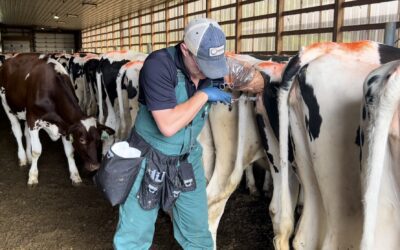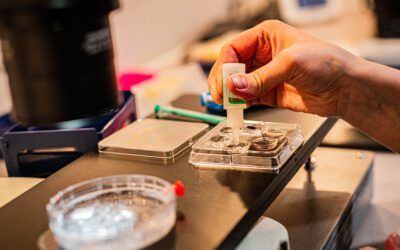Recipient management is probably the most over looked aspect of any embryo transfer program but can probably have the greatest impact on success with a modest financial investment. There is a new emerging science originating from the human realm, which is now becoming heavily investigated at universities throughout the country with significant application to bovine reproduction and genomics. To better understand how this applies to bovine advanced reproduction it is helpful to understand the historical context leading to its discovery.
The Dutch Famine of 1944, also known as the “Hunger Winter,” was a brief but severe famine near the end of World War II when the Germans occupied the Netherlands. In order to punish the Dutch for their reluctance to aid the Nazi war effort, the Germans placed a food embargo to the farming areas in the western region of the Netherlands. This embargo was partially lifted in early November 1944 but unfortunately an unusually early and especially harsh winter had already set in. The canals froze over and became impassable for barges, leaving the cities in the western Netherlands with a scarce food supply. Within a very short time period the food was gone and a population desperate to survive had their diet reduced to bread, potatoes, sugar beets and tulip bulbs, receiving as little as 400-800 calories/day. From September 1944 until early 1945 malnutrition was the primary cause of death of 18,000 Dutch people, and it was considered a contributing factor in the deaths of many more. When the Dutch Famine ended with the liberation of the western Netherlands in May 1945, around 22,000 had died and 4.5 million were otherwise affected.
This historical event was unique in the fact that over a 5 – 6 month period the severe malnutrition cut across all social economic classes of a previously well-nourished population with sudden onset and sudden relief. This almost perfectly designed, although tragic, human experiment lead to the pioneering investigation of the British physician David Barker and colleagues at the University of Southampton in 1976.
David Barker studied women who had become pregnant during this famine and found their infants were more susceptible to low birth weight, mental illness, obesity and a variety of other diseases corresponding to the trimester in which they were under-nourished. Barker’s Hypothesis was that poor nutrition in utero “programmed” the fetus to cope with low nutrient diets after birth, preparing it for the environment it would need to survive in. It appeared that the limited food intake of mothers who were pregnant during this period somehow genetically altered the fetus. Later, it was determined that these changes were not in the genetic code itself but instead a different setting for the code which indicates whether a gene is turned on or off. This scientific phenomenon is known as epigenetics, or heritable changes in gene expression. The time or place that a gene is expressed is crucially important to proper development and can alter metabolic pathways and affect the function of entire organs and body systems. There is evidence that some of these epigenetic effects observed during the Dutch Famine were even passed down multiple generations. Barker’s “fetal programming hypothesis” (known as the “Barker hypothesis”) transformed thinking about the causes of diabetes, cardiovascular disease, and cancer within the human medical community. This eventually provided crucial support and laid the foundation for the growing field known today as the developmental origins of health and disease (DOHaD).
Basically these pregnant women were modifying the development of their unborn children, switching some genes on and some genes off in order to prepare the child for survival in an environment in which resources were predicted by the mother to be scarce, resulting in a “thrifty phenotype”. On the other hand, recent research has shown that maternal over-nutrition can cause other problems like birth defects of the spinal cord, heart and limbs. Think of it as a maternal weather forecast. If the gestating mother is enjoying bountiful nutrition she will prepare her fetus for the same, and if she is experiencing starvation she will prepare her fetus for survival in an environment with limited nutritional resources. The problem with this sort of epigenetic fetal programming appears to occur when there is a mismatch in what the fetus has been prepared for and what it actually experiences once arriving on the outside …..metabolic dysfunction and disease can result. The Dutch Famine is of course an extreme example and involves humans not cows, but the principles of epigenetics have been proven to extend to other mammals including bovines, and can be affected by many factors in addition to nutrition.
Fetal Programming and Bovine Reproduction
Calves born to nutritionally restricted cows have been shown to have 60% fewer follicles on their ovaries, and bovine embryos from donors with high concentrations of urea in the uterus at the time of the flush show compromised long-term potential with reduced pregnancy rate after embryo transfer. On the other hand, a diet rich in lipids in the absence of obesity is generally favorable and results in increased reproductive performance as measured by follicular growth and oocyte and embryo quality. Daughters of cows with chronic mastitis have been shown to have lower concentrations of a specific hormone indicator for fertility called anti-Mullerian hormone, much smaller ovaries, a decreased number of high quality oocytes in ovaries and an overall reduced ovarian function. Therefore it appears that in addition to nutritional stressors, diseases such as chronic mastitis may be able to impair reproductive performance as well.
A critical issue is the relative vulnerability of different stages of development to environmental programming which may be most pertinent with respect to the in vitro culture environment. I suspect future research will reveal that there is an age dependant susceptibility to epigenetic influences and that the earlier we expose an individual genome to specific stressors or environmental conditions the more profound our influence will be. In other words, a 7 day old embryo sitting in an IVF lab would be more sensitive to these epigenetic stressors than a 75 day old fetus, etc.
I believe the realm of epigenetics as it relates to the DOHaD will be an area of significant research and will yield some of the greatest advancements in bovine advanced reproduction that our industry has seen since genomics. I suspect this future research will be aimed at revealing how we can harness the power of epigenetics and put it to work for us in our breeding programs. What environmental or nutritional conditions can we expose the gestating recipient to or even the embryo itself as it is sitting in the petri dish prior to transfer, in order to cause favorable fetal programming? Maybe we could influence milk production, fertility or disease tolerance in a positive way? What effects does heat stress or chronic exposure to certain common diseases such as mastitis, pneumonia, Leukosis or Johne’s have on fetal programming? How might a nutritional hiccup on a dairy influence the epigenetics of a developing fetus? There is a flurry of academic research projects underway at major universities throughout the country to investigating the answers to these very questions.
Barker’s Hypothesis would leave me to believe that some of the most important aspects of any advanced reproductive program occur after the flush is done, the embryos have been transferred and the veterinarian leaves the farm. The health and nutrition we give to recipients can have a critical influence on the overall health and future reproductive performance of the valuable calves they are carrying, possibly future embryo donors themselves. Now that the recip is pregnant it may be a missed genetic opportunity to turn her out in the back pasture and forget about her health and nutrition until calving time.
The author is the owner of GenOvations Inc located in Lodi,WI, specializing in embryo transfer and IVF technology.




